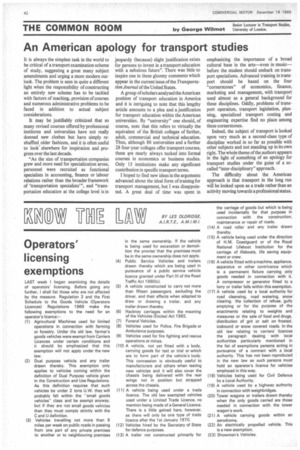Operators'
Page 44

If you've noticed an error in this article please click here to report it so we can fix it.
licensing (4)
exemptions
LAST week I began examining the details of operators' licensing. Before going any (5) further, I shall list those who are not affected by the measure. Regulation 3 and the First Schedule to the Goods Vehicle (Operators Licences) Regulations 1969 make the
following exemptions to the need for an (6) operator's licence:—
(1) Agricultural Machines used for limited (7) operations in connection with farming (8) or forestry. Under the old law, farmer's goods vehicles were exempt from Carriers (9) Licences under certain conditions and it should be emphasized that this (10) exemption will not apply under the new law.
(2) Dual purpose vehicle and any trailer drawn thereby. This exemption only applies to vehicles coming within the definition of Dual Purpose vehicle given in the Construction and Use Regulations. As this definition requires that such
vehicles be under 2 tons U.W. they will (11) probably fall within the "small goods vehicles" class and be exempt anyway. but if they are not small goods vehicles then they must comply strictly with the
C and U definition.
(3) Vehicles travelling not more than 6 miles per week on public roads in passing (12) from one part of any private premises to another or to neighbouring premises (13) in the same ownership. If the vehicle is being used for excavation or demolition the proviso' that the premises must be in the same ownership does not apply. Public Service Vehicles and trailers drawn thereby which are being used in pursuance of a public service vehicle licence granted under Part III of the Road Traffic Act 1960(c).
A vehicle constructed to carry not more than fifteen passengers, excluding the driver, and their effects when adapted to draw or drawing a trailer, and any trailer drawn thereby.
Hackney carriages within the meaning of the Vehicles (Excise) Act 1962.
Funeral Vehicles.
Vehicles used for Police, Fire Brigade or Ambulance purposes.
Vehicles used for fire fighting and rescue operations at mines.
A vehicle, not yet fitted with a body, carrying goods for test or trial or which are to form part of the vehicle's body. This concession is obviously useful to manufacturers and others when testing new vehicles and it will also cover the chassis being delivered with the rear wings not in position but strapped across the chassis.
A vehicle being used under a trade licence. The old law exempted vehicles used under a Limited Trade Licence, no mention being made of a General Licence. There is a little gained here, however. as there will only be one type of trade licence after the 1st January 1970. Vehicles hired by the Secretary of State for defence purposes.
A trailer not constructed primarily for the carriage of goods but which is being used incidentally for that purpose in connection with the construction. maintenance or repair of roads.
(14) A road roller and any trailer drawn thereby.
(15) A vehicle being used under the direction of H.M. Coastguard or of the Royal National Lifeboat Institution for the carriage of lifeboats, life saving equipment or crew.
(16) A vehicle fitted with a machine, appliance. apparatus or -other contrivance which is a permanent fixture carrying only goods needed in connection with it. A compressor or generator fitted to a lorry or trailer falls within this exemption.
(17) A vehicle used by a local authority for road cleansing, road watering, snow clearing, the collection of refuse. gully emptying or for the purpose of the enactments relating to weights and measures or the sale of food and drugs, ,distribution of grit or salt on frosted. icebound or snow covered roads. In the old law relating to carriers' licences the paragraph dealing with local authorities particularly mentioned in the list of exemptions persons acting in pursuance of a contract with a local authority. This has not been reproduced in the new law so such persons must hold an operator's licence for vehicles employed in this way.
(18) Vehicles being used for Civil Defence by a Local Authority.
(19) A vehicle used by a highway authority in connection with weighbridges.
(20) Tower wagons or trailers drawn thereby when the only goods carried are those needed in connection with the tower wagon's work.
(21) A vehicle carrying goods within an aerodrome.
(22) An electrically propelled vehicle. This is a new exemption.
(23) Showmen's Vehicles.












































































